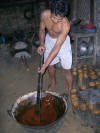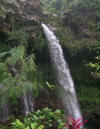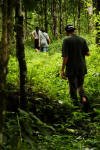Citarik Rafting and the Irony of Java Forest
Saturday morning is the day that maybe all the asiasource II participants have waited for the last one week. It was the outing day, we went out for fun. There were 3 destinations; Citarik river rafting, Mangga 2 Plaza, and the Tangkuban Perahu volcano. Most chose the Tangkuban Perahu volcano, only 11 went for rafting.
Although still located in Sukabumi district, the trip to
The landless phenomenon was rooted in the colonial age when farmers in Java lost most of their lands during implementation of land rent policy. They couldn’t afford the rent and therefore must give up the lands to Dutch colonist. After
The replacement regime was far from having effort to implement the land redistribution program. Around 3 million hectares of productive lands in Java were exploited by enterprise to produce logs and leave thousands of original owners along the island being landless and impoverished. That constitutes the major root of tenurial conflict between peasants and the enterprise (state) that last until today.
Back to oil palm drama, emergence of plantations has something to do with the newly launched government policy to promote the use of biofuel. The policy has been translated into massive conversion of productive food plantations and tropical forest to build oil palm and jatropha (the source of biofuel) plantations around the archipelago. Does this mean the Indonesians will enjoy clean and cheap energy? Not at all, it launched after the liberalization of energy sector which marked by the opening of downstream energy business for foreign enterprises. The locally extracted fuel has then been priced ‘internationally’ and fuels price raised up to over 90 percent by average in 2005.
That’s exactly what the English scholar George Monbiot feared when he criticized some european countries’ policy to replace the use of fossil fuel with biofuel back in 2003. The opening of biofuel market in the west means massive conversion of rainforest and agricultural lands in
At around ten, we arrived at Arus Liar Rafting Resort. There are also other groups of visitors who wanted to raft Citarik river. After had a short break we were transferred to the starting point uphill by vehicle where our guides prepared the boats. Only 4 people allowed for each boat because the water is low. I was with Dirk and Yolynne, guided by Rochmad, local youth working as rafting guide with Arus Liar.
Soon after our boat left the starting point, Rochmad begun yelling general commands for this water sport; forward…backward…overleft…..overright…. This young man had to work very hard not just to keep the boat stable, but also to pull it out every time it stuck on rocks.
Boom….oh it’s too late, one already fell out of boat after it jumped over big stream. Don’t worry, no injuries…it’s totally safe, man.
Later on, we had a quiet stream. That means the water is deep. Rochmad told us to jump into the water and swim. Unfortunately, the water is not clear, its dark brown, meaning that the runoff is so high.
It used to be didn’t like this when River Citarik was opened for the first time in
It was the 1998 massive protest that forced the 32 year long dictator General Suharto stepped down brought significant change in the forestry sector. Many uses term reform as “ taking back what has long been stolen “. Peasants cut and sold timbers from production forest as they believe that the power had been regained.
Unfortunately, this euphoria has shifted to rampant illegal logging since timber barons took part to grab the big cash. Almost all of forest area in Java suffered this rampant logging, including
The threat to the park is increasing as Indonesia-Australia controlled Austindo Resources plans to construct open-pit gold mine inside the park late this year with credit facility from ANZ Banking Group. Million tons of landmass will be removed from earth to create tens hectare wide mine pit. That means tens hectares of forest will also be cleared and will subsequently affect the river systems sourced from the park.
As many rafters had confirmed, the future of ecotourism business such as rafting which relies entirely upon the nature services will be badly affected by deforestation. The income source of locals working as rafting guide is being put in danger by forest exploitation. The long hard way effort to build a community-based ecotourism will be useless when the nature no longer functions as it was. No tourists willing to do rafting and the tourism business will just end for the community.
The other young guide desperately commented, “ It used to be the government who support the opening of tourism here, but why can’t they take any measure to save the future of this business upon which we rely our lives. Why didn’t they protect the forest from those massive destructions?
(this article was written during the Asiasource 2 Training Camp at Yawitra Resort, Sukabumi, West Java, 22-30 January 2006)





